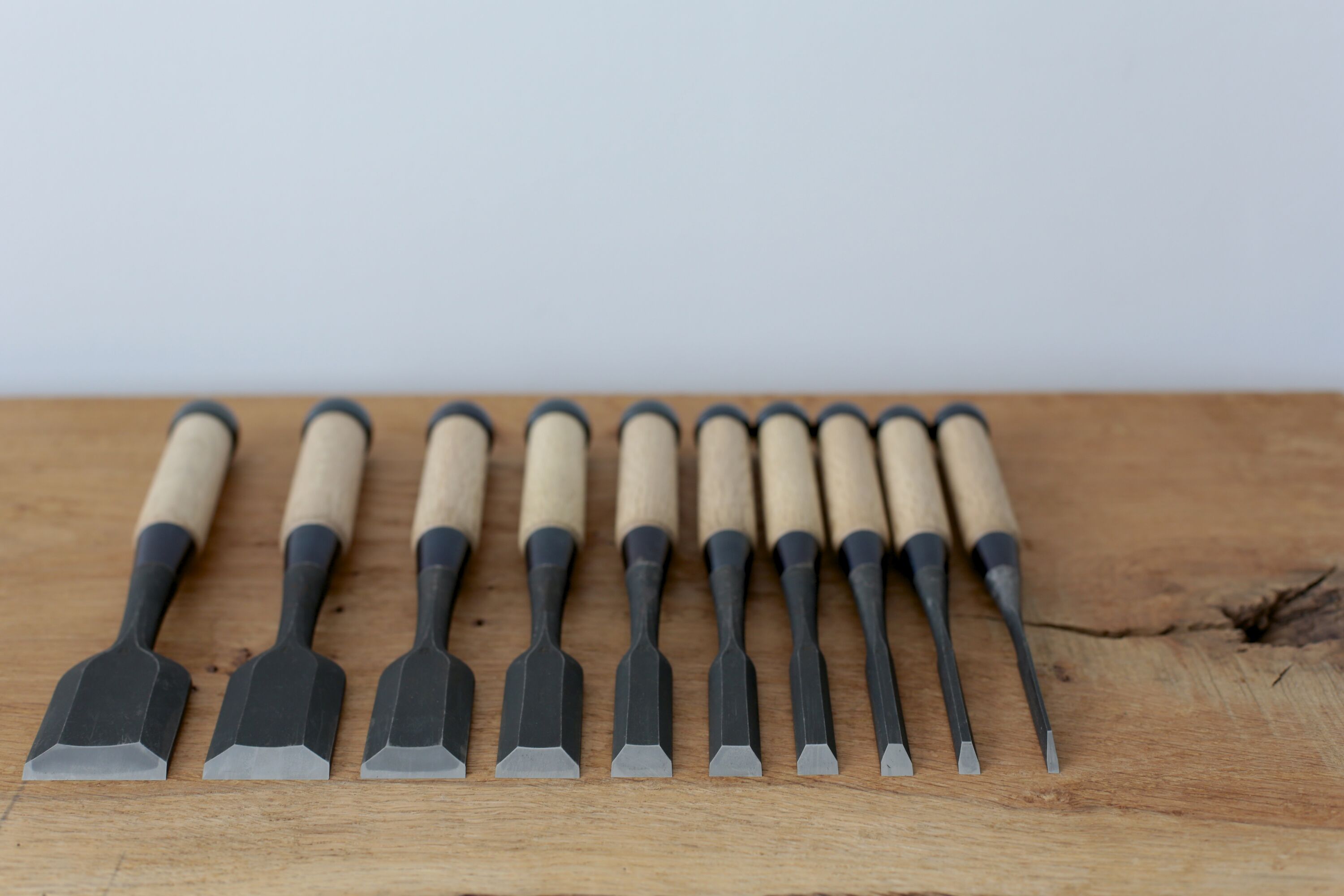In woodworking, furniture manufacturing, construction demolition, and traditional carving crafts, Steel Chisels remain indispensable hand and mechanical cutting tools. Whether for fine wood carving or dismantling structural components, high-quality chisels play a central role in modern industry and traditional craftsmanship due to their durability, precision, and versatility. With ongoing advances in forging techniques, heat treatment processes, and material science, the performance and application scope of chisels continue to evolve. So, what are the differences among various types of chisels in practical applications? How should one choose the appropriate specifications to meet different engineering requirements? This article delves into the materials, processes, applications, maintenance, and development trends of chisels.

1. Types of Steel Chisels and Their Applications
Steel chisels are mainly categorized into three types based on blade shape and usage: flat chisels, gouges, and pointed chisels. Each type has unique advantages in different scenarios.
| Type |
Blade Characteristics |
Typical Applications |
Usage Features |
| Flat Chisel |
Straight edge, adjustable width |
Wood surface leveling, furniture joints, panel smoothing |
Provides flat cuts, suitable for large area work |
| Gouge |
Semi-circular blade |
Wood grooves, curved carving |
Facilitates curved surfaces and arc-shaped structures |
| Pointed Chisel |
Sharp, slender tip |
Fine carving, hole making, detailed woodwork |
Suitable for precision work and cutting in narrow spaces |
Choosing the right type of chisel can significantly improve efficiency and reduce material waste. For example, in furniture making, flat chisels are ideal for large, flat surfaces, while pointed and gouge chisels are better suited for intricate carving.
2. Matching Chisel Specifications to Engineering Needs
Different projects require chisels of varying specifications, including blade width, edge angle, and length.
(1) Blade Width and Material Removal
The blade width determines the amount of material removed per cut:
| Blade Width |
Suitable Scenario |
Advantages |
Notes |
| 6–12 mm |
Fine woodworking, furniture trimming |
High precision, minimal waste |
Not suitable for large area cutting, may bend easily |
| 13–25 mm |
General woodworking, doors/windows |
Balance of efficiency and precision |
Requires moderate force to avoid splitting |
| 30–50 mm |
Rough work, construction demolition, large boards |
Faster material removal |
Heavier blade, requires stable support to prevent slipping |
Smaller blades are suitable for precision work, while wider blades are better for rapid material removal. Proper combination improves overall efficiency.
(2) Blade Length and Operating Range
The length of the chisel affects control and cutting depth:
Short blades (50–100 mm): Flexible for detailed carving or confined spaces; stable handling reduces deviation risk.
Medium-long blades (100–200 mm): Suitable for general woodworking and furniture making; balances precision and force transfer.
Long blades (200 mm+): Mainly for construction demolition or large wood cutting; can withstand greater impact but harder to maneuver, requiring more space and support.
(3) Edge Angle and Material Compatibility
Chisel edge angles usually range from 20° to 35°, affecting cutting depth and material suitability:
Shallow angle (20°–25°): Ideal for softwood and lightweight materials; smooth cutting and sharp edge.
Medium angle (25°–30°): Suitable for most hardwoods and furniture; balances sharpness and durability.
Acute angle (30°–35°): For hard materials and rough cutting; increases wear resistance but requires stronger force.
(4) Handle Length and Torque Control
Handle length impacts leverage and comfort:
Short handles (80–100 mm): Good for precise operations; limited force transfer.
Medium handles (100–150 mm): Ideal for general woodworking; balance of power and control.
Long handles (150 mm+): Suitable for rough work or demolition; allows greater torque but requires stronger wrist control.
(5) Selection Strategy Based on Engineering Needs
Fine carving or furniture finishing: Narrow blade, short length, shallow edge, short handle for precision and flexibility.
General woodworking and furniture making: Medium width, medium-long blade, medium edge angle, medium handle to balance efficiency and accuracy.
Construction demolition or large wood cutting: Wide blade, long blade, acute edge, long handle for power and large-area material removal.
In practice, blade width, length, edge angle, and handle must be chosen based on material hardness, cutting depth, and working space to ensure cutting efficiency and operator safety.
3. The Impact of Forging and Heat Treatment on Performance
The hardness and toughness of a chisel directly determine its service life and machining precision. Different forging and heat treatment processes produce significant performance differences:
| Process Type |
Hardness |
Toughness |
Typical Advantages |
| Traditional Forging + Normalizing |
Medium |
Relatively High |
Balanced hardness and toughness, suitable for general woodwork and construction demolition |
| Precision Forging + Quenching & Tempering |
High |
Good |
Wear-resistant edges, ideal for high-precision woodworking and carving |
| High-Carbon Steel + Tempering |
High |
Medium-Low |
Sharp cutting edges, suitable for hardwood and auxiliary metal processing |
| Alloy Steel + Surface Treatment |
High |
Good |
Enhanced corrosion resistance and wear resistance, longer service life |
Choosing the right process not only improves cutting efficiency but also extends the lifespan of steel and reduces maintenance costs.
4. Performance of Steel Chisels in Different Application Scenarios
(1) Furniture Manufacturing and Fine Woodworking
In furniture making,chisels are mainly used for mortise and tenon joints, slotting, trimming, and detailed carving.
Performance Characteristics:
High cutting precision ensures consistent joint and mortise dimensions.
Sharp edges minimize burrs and material damage.
Flexible and suitable for small-area, multi-angle operations.
Usage Strategy:
Choose narrow-blade, medium-short chisel sizes.
Use with a mallet or hand-held operation to ensure even force.
Regularly sharpen the blade to maintain sharpness and improve efficiency.
(2) Wood Carving
Carving wood requires chisels capable of handling complex lines and intricate details.
Performance Characteristics:
Small-sized chisels allow fine texture carving with precise edge control.
Different blade types (flat, gouge, pointed) can create grooves, arcs, or pointed lines.
Usage Strategy:
Use a combination of different sizes to ensure continuous carving and uniform depth.
Pay attention to angle and force to avoid breaking the edge or damaging the wood.
(3) Construction Demolition and Rough Cutting
Construction demolition and large wood cutting demand chisels with high strength and impact resistance.
Performance Characteristics:
Thick, robust edges resist impact and are less prone to breakage.
Wide blades quickly remove large areas of wood or other materials.
Blades are usually slightly blunt to ensure wear resistance.
Usage Strategy:
Long-blade, wide-edge chisels are preferred, optionally combined with large hammers or power tools.
Ensure stable support during operation to prevent rebound or misalignment injuries.
(4) Laboratory and Industrial Precision Machining
In certain laboratory or industrial precision scenarios, chisels are used for model trimming or mold micro-adjustments.
Performance Characteristics:
Precise cutting and smooth surfaces suitable for fine-tuning tasks.
Corrosion-resistant or coated chisels can withstand mild chemical environments.
Usage Strategy:
Choose small, precision chisels.
Maintain sharp edges to avoid damaging sensitive materials.
5. Safety Operation and Protective Measures
Although steel are basic tools, improper use can easily cause injuries. Key safety precautions include:
Wear protective gear: Gloves, safety glasses, and work clothing are essential.
Secure the workpiece: Use clamps to fix the material, preventing the chisel from slipping.
Use proper hammering force: Avoid excessive impact that could chip the chisel edge.
Keep the edge sharp: A dull edge is prone to slipping, increasing the risk of injury.
Regularly inspect handles and edges: Replace or sharpen chisels showing cracks or wear.
Safe operation not only protects the user but also helps extend the life of the chisel.
6. Cleaning, Sharpening, and Maintenance
Post-use maintenance directly affects the performance of the next operation. Recommended practices are as follows:
| Task |
Method |
Frequency |
| Remove debris |
Use a brush or compressed air to clear wood chips and dust |
After each use |
| Sharpen edge |
Use a whetstone or grinding wheel to reshape the edge |
According to usage |
| Rust prevention |
Apply a small amount of machine oil or rust inhibitor |
Before long-term storage |
| Organized storage |
Sort by width and purpose |
Continuous maintenance |
Proper cleaning and maintenance can significantly improve cutting precision and extend tool lifespan.
7. Evaluating Cost-Effectiveness and Durability
Choosing a chisel should consider not only performance but also cost-effectiveness:
Wear resistance: Long-lasting edges reduce replacement frequency.
Versatility: Suitable for multiple materials, minimizing tool inventory.
Cost vs. lifespan: High-hardness chisels may have higher initial cost but reduce long-term expenses due to durability and efficiency.
A comprehensive evaluation of durability and price helps engineering teams achieve high-efficiency operations within budget.
8. The Role of Steel Chisels in Traditional Craftsmanship and Modern Manufacturing
Even with the advent of electric chisels, CNC machines, and high-performance composite tools, chisels remain irreplaceable:
In manual operations, chisels provide flexibility and precise control.
High-precision carving and furniture finishing still rely on chisels for detailed work.
Electric tools cannot fully substitute manual chiseling in tight spaces or specialized materials.
Therefore, chisels continue to serve as an essential bridge between traditional craftsmanship and modern manufacturing.
9. Advantages and Reasons for Choosing Steel Chisels
The core advantages of chisels include:
High durability: High-hardness steel and proper heat treatment ensure a long service life.
High precision: Sharp edges provide clean cuts and accurate positioning.
Versatility: Suitable for a variety of materials, including wood, plastic, and soft metals.
Easy maintenance: Simple sharpening and coating care reduce long-term costs.
Strong adaptability: Can be used manually or with mechanical assistance, meeting diverse application needs.
Therefore, whether in industrial production, handcrafted work, or construction demolition, chisels are indispensable and highly efficient tools.
10. Future Outlook
With the development of materials science and heat treatment technologies, the future trends for chisels include:
New alloys and composite steels: Enhance wear resistance and toughness.
Coating technology applications: Reduce friction, resist corrosion, and extend service life.
Integration with smart manufacturing: CNC and electric assistance enable precise operations.
Steel chisels with their durability, precision, versatility, and ease of maintenance, continue to play a central role in both traditional craftsmanship and modern manufacturing, remaining an irreplaceable tool for mechanical processing and handcrafting in the future.








